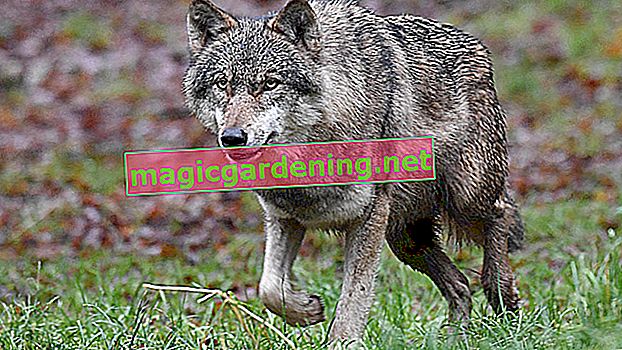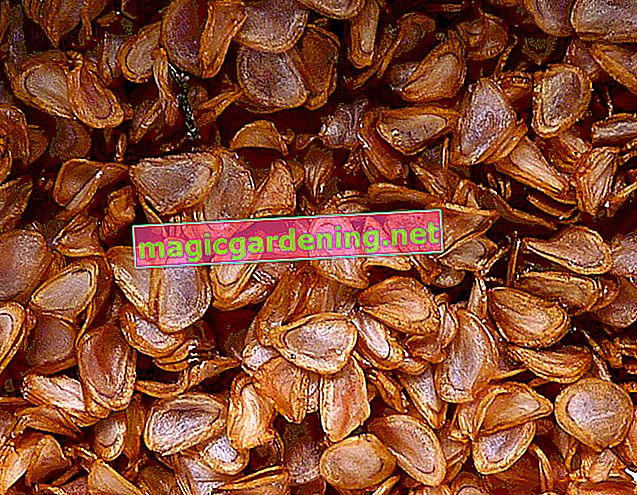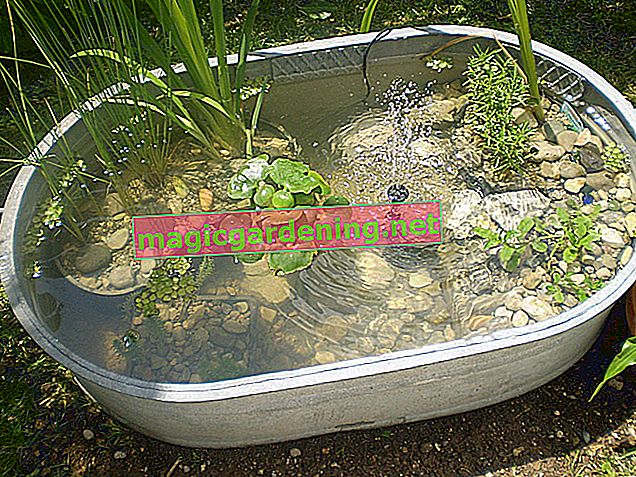
origin
Acanthus is a genus of plants that belongs to the acanthus family. It includes 20 to 30 species, the main distribution area of which is in tropical and subtropical climatic regions. Few representatives are native to the Mediterranean and Asia. The species are also known as hogweed. But the plants have nothing in common with the genus Heracleum of the same name.
also read
- Is Acanthus Hungaricus Poisonous?
- Is Acanthus Mollis Poisonous?
- Plant portrait June: The Balkan hogweed
Four types can be used as ornamental plants:
- Hungarian or Balkan hogweed (Acanthus hungaricus)
- Prickly hogweed (Acanthus spinosus)
- True hogweed (Acanthus mollis)
- Syrian hogweed (Acanthus syriacus)
growth
The plants are persistent and mostly herbaceous. Few Acanthus species grow as semi-woody shrubs. They often develop underground rhizomes that serve for survival and vegetative reproduction. With the help of the runners, the plants form dense stands. The stem grows prostrate or upright. The stature heights of the individual species are very different. They are between 30 and 150 centimeters.
leaves
The acanthus family mostly develop opposite leaves. Few species have whorled or basal heaped leaves. In all species they are divided into stem and blade. The leaves can have a simple structure. All four ornamental plants develop deeply incised, pinnately split leaves with a smooth or toothed to thorny leaf margin. They are reminiscent of oversized dandelion leaves and are known as ornamental because of their distinctive shape.
blossom
During the flowering period, Acanthus species are a real eye-catcher, because their annual inflorescences are covered with single, hood-shaped flowers. Her four petals are fused together to form a partially reduced upper lip and an enlarged lower lip, which ends in three blunt petal lobes. The flowers grow up to five centimeters long and are supported by two bracts that are armed with thorns. They enclose the flower like a collar. The inflorescence reaches heights between 40 and 200 centimeters.
Heyday
The flowers appear between June and August. They are whitish in color and often develop pink nuances. Some species have strong pink petals. Among the wild forms there are yellow, scarlet or blue flowering species.
fruit
In autumn, numerous capsule fruits containing between two and four seeds appear on the inflorescences. When the fruit is ripe, the capsules burst explosively along pre-formed seams, so that the seeds are ejected.
use
The plants are suitable for creating colored perennial beds. Large species come into their own in single or pair positions. Lower ornamental plants harmonize in small groups. Acanthus shrubs fit perfectly into the natural garden because of their wild shape. Because of the ornamentally shaped leaves, the plants harmonize with stone walls, water basins or next to stone steps on terrace slopes. Since the parent species of the ornamental plants come from the Mediterranean region, they are suitable for the design of Mediterranean gardens. They set color accents in stone structures.
These plants go well with Acanthus:
- Catnip (Nepeta)
- Yarrow (Achillea)
- iris
- Sea kale (crambe)
- Stuffed gypsophila (Gypsophila paniculata)
Is Acanthus Poisonous?
Acanthus species are not poisonous and can be planted in the garden without hesitation. Many types are used in naturopathy. They relieve coughs and help with respiratory illnesses, flu and colds. Externally, extracts of the plant parts are used for gout, sprains or bruises. Ointments promote the healing of burns and wounds.
Which location is suitable?
The species from the Mediterranean region prefer locations on scree slopes and in stony terrain. Tropical plants need more humid locations. All ornamental plants thrive splendidly in sunny locations. They tolerate partially shaded locations.
What soil does the plant need?
Cultivated Acanthus species feel comfortable on a well-drained substrate with nutrient-rich and profound properties. They like fresh floors. Brief drought does not cause them any problems. A slightly loamy soil that can store moisture is ideal. If the water builds up in the substrate, the roots rot quickly.
The correct planting distance
Before planting, note that the perennials can take on considerable proportions. Low-growing companion plants are quickly displaced. Place Acanthus in the bed at a distance of at least 70 centimeters to neighboring plants. There should be no more than two copies per square meter.
Acanthus propagate
In the spring you can multiply hogweed by division. Divide the excavated rhizome into several pieces so that each piece of root has enough fine roots and shoots.
Acanthus species can also be propagated using root cuttings. In autumn, cut a rhizome into pieces about eight centimeters long and stick the cuttings in a mixture of sand and peat. The substrate is covered with a two-centimeter layer of earth and moistened. Store the jar in a cool place. As soon as the first shoots appear, the pot is placed in a bright spot.
sowing
Immediately after flowering, you can harvest the unripe capsules and store them in a sealed container. Here the seeds continue to ripen until the fruits burst. The seeds are scattered on potting soil between November and March and lightly covered with soil. The seeds of the Acanthus species are dark germs.
The substrate should be kept slightly moist for the next two to four weeks. Place the planter in a bright place with temperatures between 18 and 22 degrees Celsius. After this phase, the seeds need a cold stimulus that stimulates germination. The pot is put in a cool place for the next four to six weeks. Here the temperatures should be between just below zero and four degrees. It can take up to ten weeks for the cotyledons to show up.
Acanthus in a pot
The plants develop tap roots that reach deep into the earth and require a lot of space. Acanthus thrives in deep pots that have been adequately drained. Do not choose the pot too big, but transplant your Acanthus annually in slightly larger containers.
Since the perennials love warmth, they are perfect for cultivation in raised beds, provided their longitudinal axis is north-south. The vertical wooden walls make optimal use of the sun's rays in the morning and in the afternoon.
This is what the potted plant soil is like:
- coarse-grained parts for a loose structure
- ideally suited: lava gravel, expanded clay (€ 17.50 at Amazon *) or gravel
- loamy parts for water storage
balcony
Acanthus feels particularly at home in a pot on south-facing balconies with airy conditions. Container plants should be watered regularly and thoroughly during the summer months. The perennials enjoy watering once a week.
Watering acanthus
Keep the substrate slightly moist. Acanthus enjoys moderate watering. The perennial tolerates slight drought. Waterlogging should be avoided so that the roots do not rot.
Fertilize acanthus properly
Occasionally give the perennials plant stock via the irrigation water. They strengthen the vitality and make Acanthus more resistant to diseases and pests. In spring you can work some rock flour (€ 14.95 at Amazon *) or compost into the substrate. Further fertilization is not necessary.
Cut acanthus properly
The inflorescences remain over the winter. They are stable and are a real eye-catcher during the gray season. In spring the perennial is cut back close to the ground. The inflorescences can be placed in vases as cut flowers.
How do I transplant properly?
Ingrown acanthus shrubs can be removed from their location with a lot of effort. Since the roots reach deep into the ground, the rhizomes are broken up when transplanting. If you want to remove the perennials from a location, you will need to regularly dig up freshly sprouting rhizomes. Choose the location wisely before planting. Acanthus develops splendidly if it grows undisturbed over several years in one location.
Hardy
Although the species are considered hardy, winter protection is advisable. A thick layer of bark mulch and straw or spruce and fir branches protect the rhizome from frostbite. In snowy regions, the plants are optimally protected by a closed snow cover.
Container plants should be placed on an insulating base. This can be a styrofoam plate (€ 25.90 at Amazon *) or a piece of wood. The pot is wrapped with fleece, jute or plastic wrap so that the substrate does not freeze. A location protected from rain prevents waterlogging in the substrate. You can also overwinter potted plants indoors. Put the bucket in an unheated room.
Fungal attack
Acanthus is occasionally attacked by powdery mildew. The fungal spores spread in dry and warm conditions. They colonize weakened or diseased plants and leave a wipeable coating with a flour-like structure on the leaves. The risk of infestation can be reduced by a layer of mulch. It ensures constantly moist conditions in the substrate and increases the humidity.
Acanthus does not bloom
While the Hungarian hogweed flowers reliably every year, its three related ornamental plants often show irregular flower development. If the perennials do not bloom, a too harsh winter may be the cause. Ground frost causes the rhizome to freeze back and partially wear off. The damaged rhizomes sprout reliably, but the young plants need two to three years for the first flowers. The underground plant parts can be protected with winter protection.
Tips
All four ornamental plants can be distinguished by their leaves. The flowers are very similar. When buying, pay attention to the foliage if the variety has not been assigned to a parent species.
sorts
- Hollard's Gold : Acanthus mollis hybrid with white to light purple flowers, blooms between July and August. Up to 120 centimeters high.
- White Lips : Acanthus hungaricus hybrid with a white crown and purple bracts, flowers from June to August. Up to 70 centimeters high.
- Mornings Candle : hubris from Acanthus mollis and spinosus. White flowers with purple bracts. Flowering time from July to August. Growth height up to 100 centimeters.
 Growing station light garden 99.99 EUR Buy from Pötschke
Growing station light garden 99.99 EUR Buy from Pötschke








